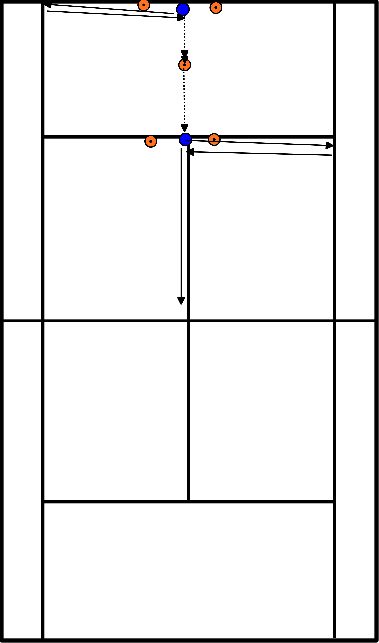Tennis drills
- Which pair can play the ball independently over the net most often?
- The tennis players are close to the net.
- You can make it more difficult by increasing the distance.
- Between the two tennis players are 2 hoops, about one meter apart.
- Try to get the ball into each other's hoop (who has the most hits).
- More difficult: between both tennis players. each on one side of the net, on each side of the net 2 hoops (hoops must be in the same place on both sides)
- Play the ball over the net and try to leave the ball in the other hoop.
- Which pair plays the ball with the forehand most times over the net in a certain period of time,
- You can count every good forehand stroke,
- If the ball goes wrong, you don't have to start again,
- You may now continue to count.
- Expansion possibilities are
- playing backhand only
- and/or use both techniques.
- Put the ball on the racket: let the ball roll over the strings, the ball must not roll off the racket
- keep the ball on the racket, while you touch the floor, sit down, get up, limp, run etc.
- Try to keep the racket at chest height at all times.
- Throw the ball up with the racket and catch it again with the racket
- Throw the ball a little bit in front of you
- Run after it and catch it again with your racket.
- throw ball up let it bounce once and then catch it with the racket
- keep playing up the ball, don't catch it anymore
- try to walk around when you play the ball up, who succeeds without mistakes and without touching anyone
- The teacher will recap briefly the previous lesson.
- What did we do and what did you learn?
- It was about serving and returning and the experience that tennis is not that difficult at all and can be quite intense.
- The instructor explains that today we will technically zoom in on forehands and backhands, tactically on point building and doubles and in general on cooperation and communication.
- Each pair tries to play over, with each student trying to rush the other by creating space and hitting the ball in space.
- The emphasis is really on trying.
- Besides using the space, they can experiment with hitting harder, taking the ball earlier and deliberately slowing down the game.
- The teacher gives different lengths of lane (using the lines present in the room) to experience how hard / soft / high / low / deep the ball should be hit to be able to play together within this assignment.
- After the ball has been hit wrong twice, the two of them will switch to the waiting two on their lane.
- The students who are waiting can check the assignment and 'play along' in their minds.
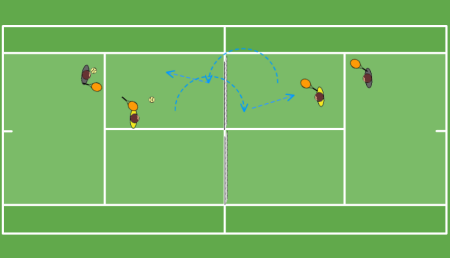
- Stay in the rally The student is able to:
- To strike forehand- and backhand techniques in doubles and singles in different ways.
- To indicate which principles apply when building up a point.
- To start up and maintain independent play and practice forms.
- To take part in the lesson with attention and understanding, focus, hungry for work and combativeness.
- To work and consult together.
- Apply knowledge of the rules.
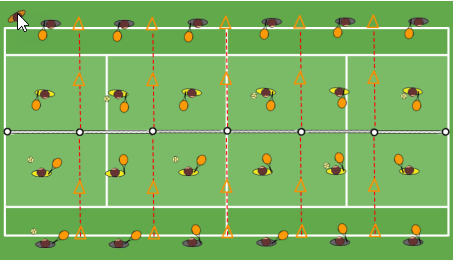
- Stay in the rally The student is able to:
- To strike forehand- and backhand techniques in doubles and singles in different ways.
- To indicate which principles apply when building up a point.
- To start up and maintain independent play and practice forms.
- Participate in the lesson with attention and understanding, focus, hungry for work and combativeness.
- To work and consult together.
- Apply knowledge of the rules.
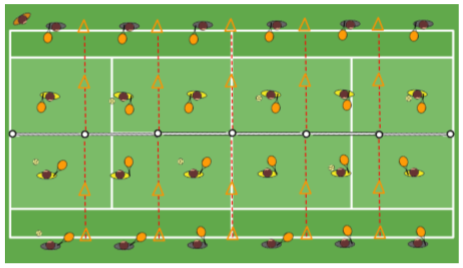
- We work in pairs.
- The ball is brought into play with a (forehand) service.
- The students play with forehands at each other, where the height (under a magic cord) and depth (newspaper) is controlled.
- Every time the newspaper is hit, you get a point.
- Who has the most points after X time?
- The teacher's example shows balance ('standing firmly') and the shape of a 'quiet swing'.
- Extra assignment there are three different newspapers for the students. (left-middle-right)
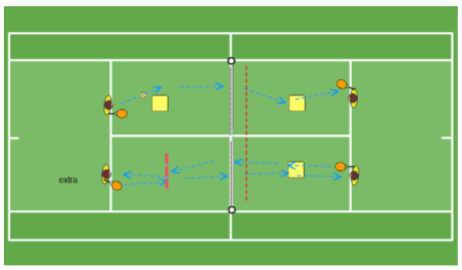
- Put a ball on the players rackets, and let them steal each other's balls without falling off.
- If their ball is stolen or falls off, let them run e.g. for 1 round
- Depends on the age!
- between the two tennis players are 2 hoops, about a meter apart.
- Try to get the ball into each other's hoop (who has the most hits)?
- More difficult: between the two tennis players.
- each on one side of the net, on each side of the net 2 hoops (hoops must be on the same spot on both sides), play the ball over the net and try to bounce the ball in the other hoop.
Work in pairs:
- 2 players face each other in the middle of the cones/balls/rackets.
- 1 player = follower
- 1 player = escaper/runner
- At the start signal, the runner tries to misdirect the follower.
- There's a ball on both rackets/pistons and the runner must try to take it without the follower being able to tap it.
- tapping with tennis ball in hand
- Successful = 1 point (first 3) and then change.
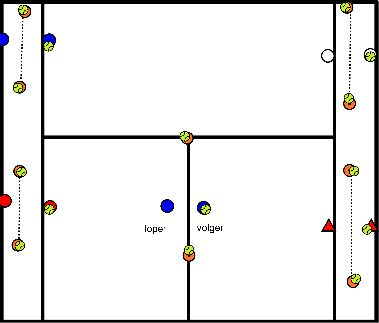
- POSITION 1: KNEES LIFT LENGTH BASELINE _ NET
- POSITION 2: LUNGES WITH ROTATION FH/ BH
- POSITION 3: TAPPING LINES WITH HAND / RACKET // SERVICE BOX
- POSITION 4: SKATE ON THE DOUBLE LINES WITH BALANCE
- POSITION 5: RCKET JUMPING L-R
= Sliding through system: Lunges- knees lift- racketspin-lines taps- 1 leg jumps with balance
exercise takes 1 min - 30 sec rest (move to next exercise) = 7.5 min/ lap = 2 rounds = 15 min
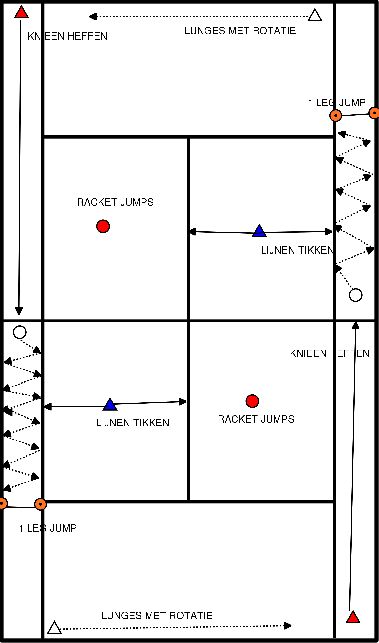
SPLIT AND AGILITY
- Set up 2 sides of the net:
- 2 cones (split point + direction)
- 1 cone ( make circle)
- 2 cones miniline (splitstep+ direction)
- sprint up to the net.-> Get in line. (5 per row)
- 2 cones (split point + direction)
https://www.instagram.com/p/BZ0jkxBnThM/
